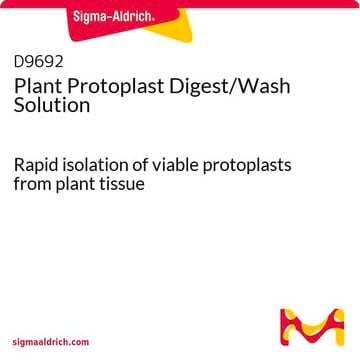This product is a high purity, high activity cellulase derived from Trichoderma viride. An isoenzyme profile has not been performed. The link below may be useful:
https://febs.onlinelibrary.wiley.com/doi/full/10.1111/j.1432-1033.1985.tb08653.x
Kluczowe dokumenty
C0615
Cellulase from Trichoderma sp.
powder, ≥5,000 units/g solid
Synonim(y):
Onozuka RS
Wybierz wielkość
1200,00 zł
Wybierz wielkość
About This Item
1200,00 zł
Polecane produkty
Formularz
powder
aktywność właściwa
≥5,000 units/g solid
charakterystyka ekologicznej alternatywy
Waste Prevention
Design for Energy Efficiency
Learn more about the Principles of Green Chemistry.
sustainability
Greener Alternative Product
rozpuszczalność
deionized water: soluble 3.0 mg/mL (Sterile; In the presence of 0.15% polyhexamethylene biguanide (PHMB))
kategoria ekologicznej alternatywy
temp. przechowywania
2-8°C
Szukasz podobnych produktów? Odwiedź Przewodnik dotyczący porównywania produktów
Powiązane kategorie
Opis ogólny
Zastosowanie
Działania biochem./fizjol.
Definicja jednostki
Uwaga dotycząca przygotowania
Inne uwagi
Hasło ostrzegawcze
Danger
Zwroty wskazujące rodzaj zagrożenia
Zwroty wskazujące środki ostrożności
Klasyfikacja zagrożeń
Resp. Sens. 1
Kod klasy składowania
11 - Combustible Solids
Klasa zagrożenia wodnego (WGK)
WGK 1
Temperatura zapłonu (°F)
Not applicable
Temperatura zapłonu (°C)
Not applicable
Środki ochrony indywidualnej
dust mask type N95 (US), Eyeshields, Faceshields, Gloves
Wybierz jedną z najnowszych wersji:
Certyfikaty analizy (CoA)
Nie widzisz odpowiedniej wersji?
Jeśli potrzebujesz konkretnej wersji, możesz wyszukać konkretny certyfikat według numeru partii lub serii.
Masz już ten produkt?
Dokumenty związane z niedawno zakupionymi produktami zostały zamieszczone w Bibliotece dokumentów.
Klienci oglądali również te produkty
Protokoły
To standardize an enzymatic assay procedure of cellulase.
Ten protokół wykorzystuje test spektrofotometryczny do oceny aktywności celulazy. Celulaza z Aspergillus niger katalizuje hydrolizę wiązań endo-1,4-β-D-glikozydowych.
-
¿What cellulases does the lyophilized powder C0615 contain? and ¿what is the ratio?
1 answer-
Helpful?
-
-
What is the Department of Transportation shipping information for this product?
1 answer-
Transportation information can be found in Section 14 of the product's (M)SDS.To access the shipping information for this material, use the link on the product detail page for the product.
Helpful?
-
-
Does product C0615, cellulase from Trichoderma viride, contain any sugar as a stabilizer?
1 answer-
No. Product C0615, cellulase from Trichoderma viride, does not contain any sugar stabilizer.
Helpful?
-
Active Filters
Nasz zespół naukowców ma doświadczenie we wszystkich obszarach badań, w tym w naukach przyrodniczych, materiałoznawstwie, syntezie chemicznej, chromatografii, analityce i wielu innych dziedzinach.
Skontaktuj się z zespołem ds. pomocy technicznej









